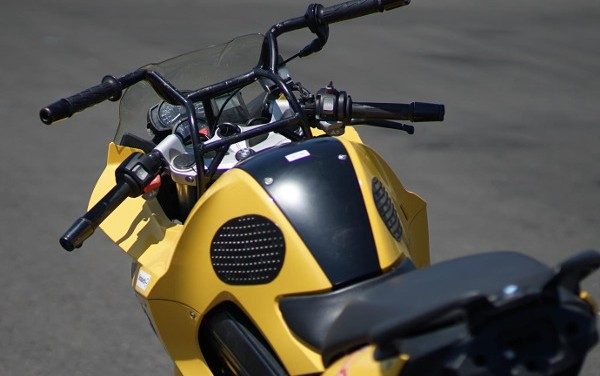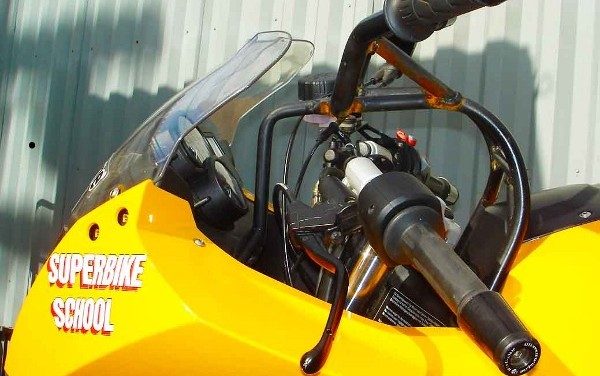

The Correct Brothers
It’s alarming that riders still question how to steer their motorcycle. Apparently, even after 90 years when it was first observed by the Wright brothers some confusion remains on this subject. Yes, their first engineering attempts were as bicycle manufacturers, but the very observant brothers, determined that tandem-wheeled (one wheel in front of the other) vehicles countersteer. That was and still is correct.
Sources of Confusion
It is easy to see how confusion arises on the subject of steering for any of us who started their riding on pedal bikes. The steering is so light on a bicycle that riders have difficulty separating the shift of their body mass (leaning into it) with the slight effort it takes to countersteer.
Further confusion arises from word of mouth advice on riding. Articles in usually credible national magazines extolling the virtues of body mass type of steering-Body Steering as it is called. Most riders still believe that some of the steering is being done with their body mass or weight shift or pressure on the motorcycle’s tank or pegs. Their estimates on how effective these are in getting the bike to turn range anywhere from 10% to 90%, some believe all of it is weight shift.
Swoopy Steering
If it weren’t so grim, it’s almost comical to watch a rider who does not understand how steering is accomplished. You can see them riding down the freeway trying and failing to change lanes by body steering and still appear cool while doing so. I have seen it dozens of times. It goes like this: The rider does a very swoopy upper body swing in the direction he wishes to go but for an agonizing (to me) moment, nothing happens. There is a perceivable lag between the upper body swoop and the bike’s deflection from its original course. How terrifying it must be to find that the bike doesn’t instantly respond.
Stiffen To Steer
Following the swoop is a stiffening of the rider’s upper body. Only then does the bike respond and change lanes. You see how this works? The rider’s body is positioned off-center, from his swoop, in the intended direction of the lane change. The stiffening on the bars creates the countersteering action, because he has either pushed on the inside bar or stiffened and pulled on the outside one or a combination of both. This stiffening is actually a mild panic reaction. Many riders have simply learned to live with the lag and to think it is how their bike handles. That is false. A motorcycle responds almost instantly to countersteering.
Vague Technique
Riders have a number of ideas, which are vague and hard for them to describe, on just how their weight shifting accomplishes this so-called body steering. “Throwing” their upper body mass to one side or the other (the swoop) is one. Some say they just push down on the inside peg. Some say they pull the bike over with the outside leg against the tank. Some say it is a combination of two or even all three of the above methods. Do they work?
We’ll leave it up to the tech boys to figure out the WHY of motorcycle counter-steering. Their job should be to provide a simple demonstration of how it works. The fact is that countersteering is still being argued in the halls of learning with slide rules, physics formulas and calculators. Many theories exist, but no conclusive statement that we know of, as to why, has yet been reached. Argue on, boys.
Clear the Issue
Our job is to make riding simple and to clear up conflicting information that a rider may have on the subject of riding. Any confusion translates into reduced control, as in the lag from swoop to lane change, and confidence, as in the bike won’t do what I want it to, when I want it to. Riders don’t like the uncertainty and love the feeling of confidence. We decided to clarify this steering issue, body vs counter, very simply and very plainly. We reasoned that anyone who could see how it works and experience the real steering procedure would have dramatically improved their chances of survival against the perils of 21st Century Earth street riding. Steering must be done and done quickly if a rider has any hope of confidently neutralizing those perils.
Expert Opinions
I was actually in a deep confusion on this subject of body steering myself. Riders the caliber of Eric Bostrum have told me that they do it to some degree, to help steer. Freddie Spencer has made a statement to that effect and of course Reg Pridmore has made it the banner for his CLASS schools for 15 years. Jason’s STAR school has been written up as teaching body steering as well.
With great to good credentials like that, it should be so, and even I was a little shaken in my certainty. Maybe there was something in it after all. I hate to miss anything.
The Experiments
For my part, experimenting with pressure on the pegs, the tank, adjusting my body mass and combinations of all three on the bike resulted in nothing I would consider steering. In other words, something that could be used in an emergency maneuver or to aggressively flick the bike into a corner or through a set of esses.
Eventually I arrived at a potential solution to my questions that would eliminate my opinions and/or misunderstanding on the subject.
The Solution
Make a bike that has two sets of bars. One set as normal, the other set would be solid-mounted to the frame so they were not connected to and did not rotate the forks. This, as my theory went, would answer the question. And it does.
The Machine
Taking one of our Kawasaki ZX 6Rs and solid-mounting a set of bars 8″ above the standard ones would positively isolate the various body shifting from the counter steering. If body steering had any effect it would be simple to show it. I created a bike with that setup. One necessary detail was to mount an additional throttle on the upper, solid-mounted bars, so the bike’s stability could be maintained as the user rode down the road. So we wound up with two sets of handlebars and two operating throttles on the bike.
Dirty Exceptions
Before I go any further I want to address off-road motorcycles. An off-road motorcycle will easily steer by pressing down on the inside peg, and in conjunction with shifting the upper body mass, will go over pretty easily. Still not what I would call good control but it can be done fairly efficiently.
Again, I am not a true tech guy, but it occurs to me that the small contact patch on knobbies or dual sport tires plus dirt bike steering geometry (which is not intended to provide an enormous amount of stability at speed) contribute to the reasons why steering results from weight shifts to the degree it does on a dirt bike.
No B.S.
Now, in the 21st century, we have run nearly 100 riders of all experience levels on this double-barred bike. It has made believers out of every single one in the actuality of countersteering of course. Even at speeds of no more than 20 to 35 mph, no matter how much you tug or push or pull or jump around on the bike, the best we saw was that the bike wiggled and became somewhat unstable. Did it turn? Not really. Would it turn at higher speed? Absolutely not. Could you avoid something in your path? No way. Could anyone quick turn the bike? Hopeless! The best result was one of my riding coaches. He got into a full hang-off position and was able to persuade the bike, by jerking on it, to start on a wide, wide arc in the paddock at Laguna Seca, a piece of asphalt that is about 500 x 800 feet. It was like turning an oil tanker ship and starting at noon to be on the turning arc at around 1:00 PM. It wasn’t smooth and it wasn’t very effective.
We now call this bike “The NO BS Bike”. There are no doubts in anyone’s mind after they ride it that they have been countersteering all along. No doubts.
You can hear riders who believed in the body steering method, laughing in their helmets at 100 yards away, once they get those solid-mounted bars in their hands and try to body steer the bike. They just shake their heads. No B.S.
Dangerous Misconceptions
Now if you want to look a little further into this, what you will see is this: riders who still labor under the misconception that they body steer are devoting themselves to a system that can do a great deal of actual harm. Firstly, it is seriously misguided to add an additional series of actions to the steering process. When it is quick, critical steering that is needed to avoid something, that lag I have observed so many times in street riders, could cost you your hide.
Adding 2/10ths to 5/10ths of a second, or more, to the steering procedure at 60 mph means that you have just gone another 18 to 44 feet, or more, down the road before you started to avoid that muffler lying in your path. Kids, don’t try this at home.
The way things are going there will be warning labels on motorcycles in the not too distant future.
WARNING: THIS VEHICLE COUNTERSTEERS. IF YOU DO NOT UNDERSTAND COUNTERSTEERING DO NOT RIDE. SEEK THE HELP OF A QUALIFIED PROFESSIONAL RIDING COACH.
Bull Steering
Another recognizable error, resulting in excess effort used to steer the motorcycle, is the attempt to turn the bike by bulldogging the bars. An interesting combination of pulling up on one and pushing down on the other, rodeo style, like bull wrestling. No, repeat no, steering results from this. None, zero, nadda, niente. Riders who think they can twist the bike into a turn in this fashion simply have another false idea and get tired. The Bottom Line.
Steering a motorcycle results from the process of pushing the inside bar forward, the same angle and direction the forks rotate in the steering head bearings. You can also pull on the outside bar. You can do both push and pull. That is what turns it; that is all that turns it with any degree of accuracy, efficiency, quickness or smoothness. That and only that, no B.S.
~ Keith Code





